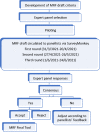Development and Delphi consensus validation of the Medication-Related Fall screening and scoring tool
- PMID: 38753075
- PMCID: PMC11286707
- DOI: 10.1007/s11096-024-01734-w
Development and Delphi consensus validation of the Medication-Related Fall screening and scoring tool
Abstract
Background: Falls are a significant public health problem and constitute a major cause of injuries and mortality. Risk factors for falls are multifactorial and include medication use.
Aim: To develop and investigate the content validity of the Medication-Related fall (MRF) screening and scoring tool.
Method: The MRF tool was developed from clinical practice guidelines addressing medication-related problems, and additional medications identified by specialist pharmacists across a region of the United Kingdom (Northern Ireland). Medication classes were categorised according to their 'potential to cause falls' as: high-risk (three points), moderate-risk (two points) or low-risk (one point). The overall medication-related falls risk for the patient was determined by summing the scores for all medications. The MRF was validated using Delphi consensus methodology, whereby three iterative rounds of surveys were conducted using SurveyMonkey®. Twenty-two experts from 10 countries determined their agreement with the falls risk associated with each medication on a 5-point Likert scale. Only medications with at least 75% of respondents agreeing or strongly agreeing were retained in the next round.
Results: Consensus was reached for 19 medications/medication classes to be included in the final version of the MRF tool; ten were classified as high-risk, eight as moderate-risk and one as low-risk.
Conclusion: The MRF tool is simple and has the potential to be integrated into medicines optimisation to reduce falls risk and negative fall-related outcomes. The score from the MRF tool can be used as a clinical parameter to assess the need for medication review and clinical interventions.
Keywords: Assessment tool; Fall-risk increasing drugs; Falls; Medication review; Older people; Polypharmacy.
© 2024. The Author(s).
Conflict of interest statement
The authors declare that they have no conflicts of interest that are relevant to the content of this article.
Figures
Similar articles
-
STOPPFall (Screening Tool of Older Persons Prescriptions in older adults with high fall risk): a Delphi study by the EuGMS Task and Finish Group on Fall-Risk-Increasing Drugs.Age Ageing. 2021 Jun 28;50(4):1189-1199. doi: 10.1093/ageing/afaa249. Age Ageing. 2021. PMID: 33349863 Free PMC article.
-
STOPPFrail (Screening Tool of Older Persons Prescriptions in Frail adults with limited life expectancy): consensus validation.Age Ageing. 2017 Jul 1;46(4):600-607. doi: 10.1093/ageing/afx005. Age Ageing. 2017. PMID: 28119312
-
What are priorities for deprescribing for elderly patients? Capturing the voice of practitioners: a modified delphi process.PLoS One. 2015 Apr 7;10(4):e0122246. doi: 10.1371/journal.pone.0122246. eCollection 2015. PLoS One. 2015. PMID: 25849568 Free PMC article.
-
A Systematic Review of the Guidelines and Delphi Study for the Multifactorial Fall Risk Assessment of Community-Dwelling Elderly.Int J Environ Res Public Health. 2020 Aug 21;17(17):6097. doi: 10.3390/ijerph17176097. Int J Environ Res Public Health. 2020. PMID: 32825699 Free PMC article.
-
Geriatric Polypharmacy: Pharmacist as Key Facilitator in Assessing for Falls Risk.Clin Geriatr Med. 2017 May;33(2):205-223. doi: 10.1016/j.cger.2017.01.003. Epub 2017 Feb 14. Clin Geriatr Med. 2017. PMID: 28364992 Review.
References
-
- World Health Organization (2017) WHO global patient safety challenge: medication without harm. Available at: https://www.who.int/initiatives/medication-without-harm. Accessed 15 Jan 2024.
-
- Rubenstein LZ. Falls in older people: epidemiology, risk factors and strategies for prevention. Age Ageing. 2006;35(Suppl 2):ii37-41. - PubMed
-
- Walsh ME, Boland F, Moriarty F, et al. Modification of potentially inappropriate prescribing following fall-related hospitalizations in older adults. Drugs Aging. 2019;36(5):461–70. - PubMed
-
- Maly J, Dosedel M, Vosatka J, et al. Pharmacotherapy as major risk factor of falls—analysis of 12 months experience in hospitals in South Bohemia. J Appl Biomed. 2019;17(1):60. - PubMed
Publication types
MeSH terms
LinkOut - more resources
Full Text Sources
Medical
Miscellaneous



